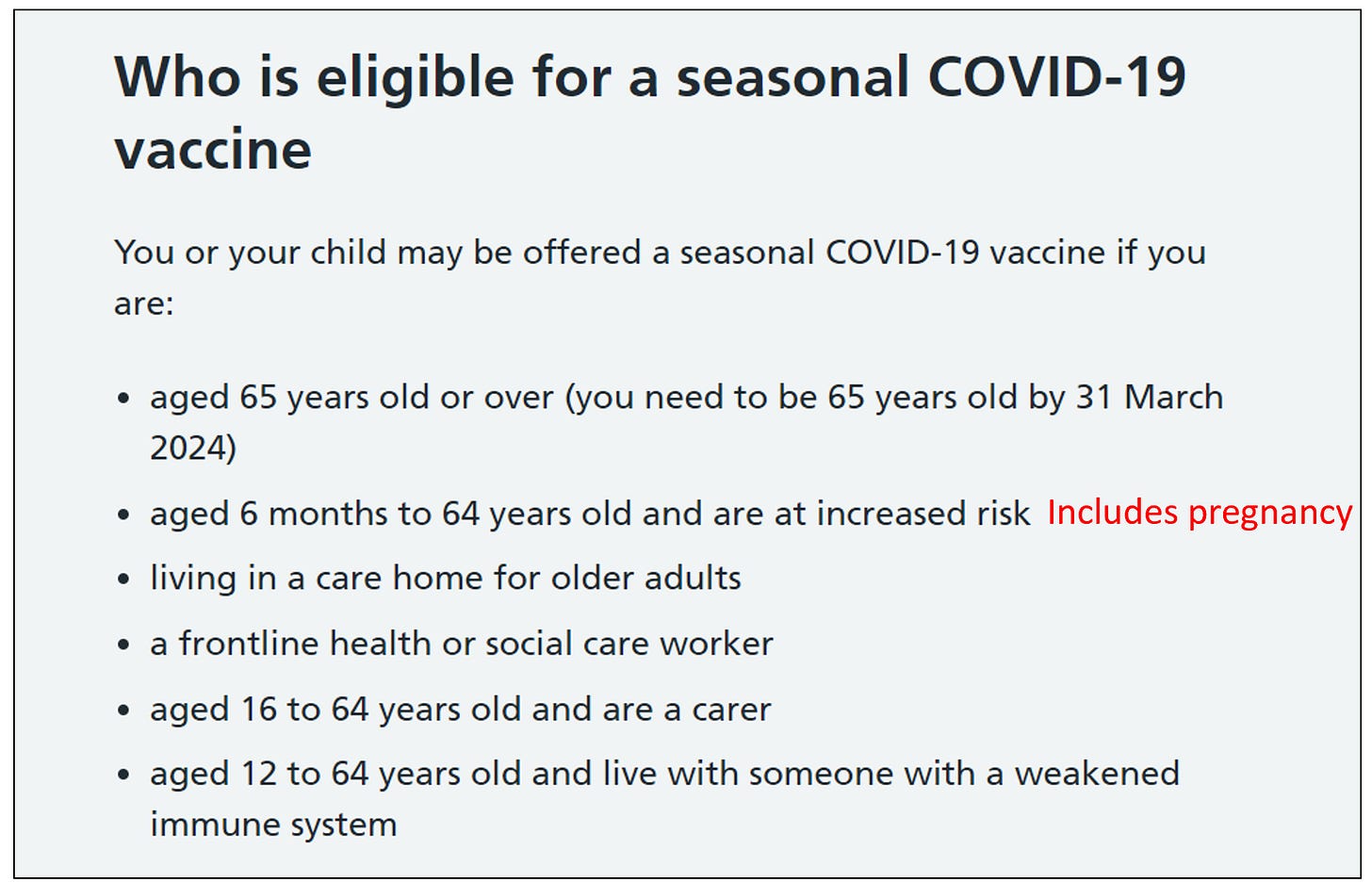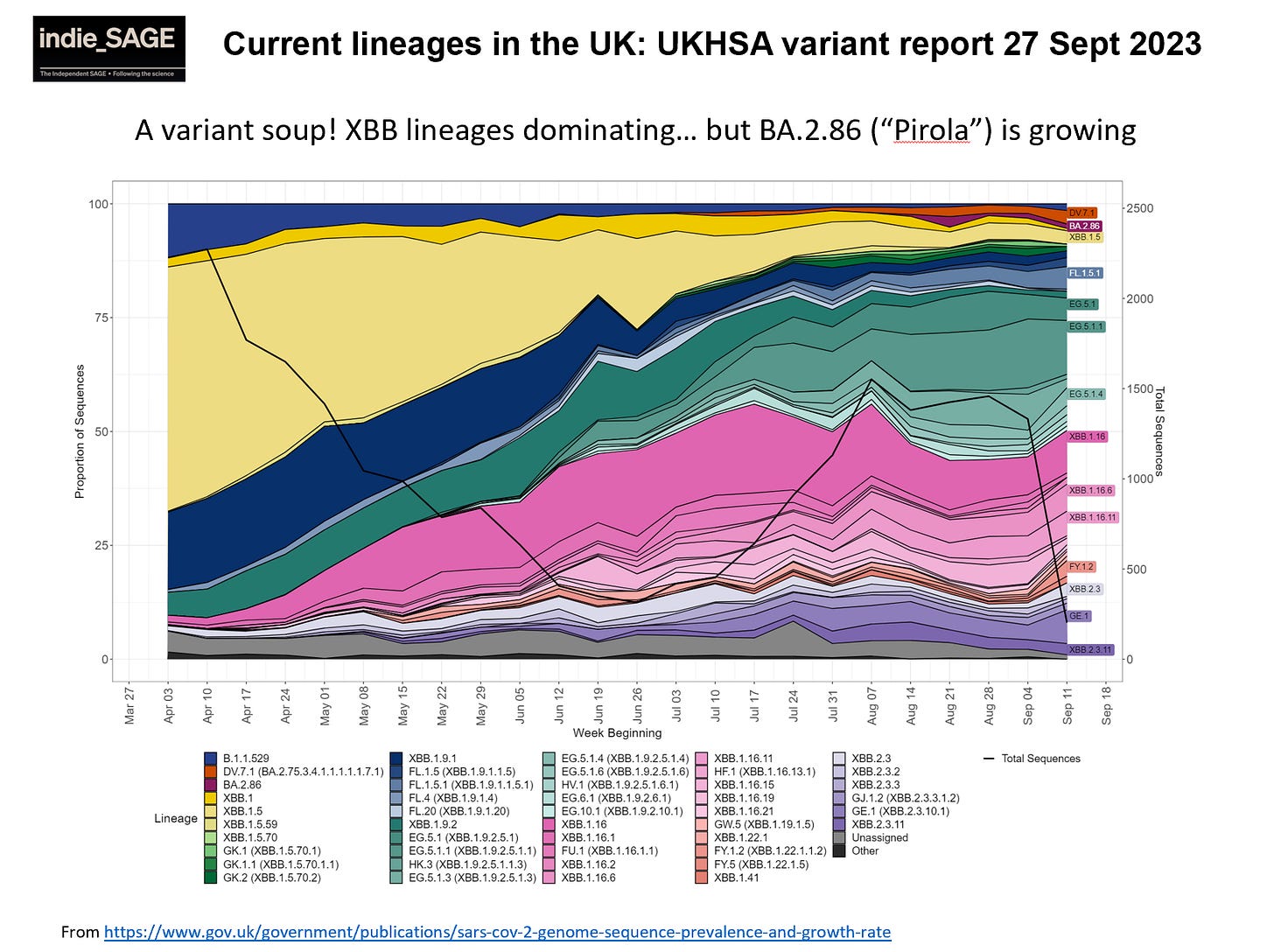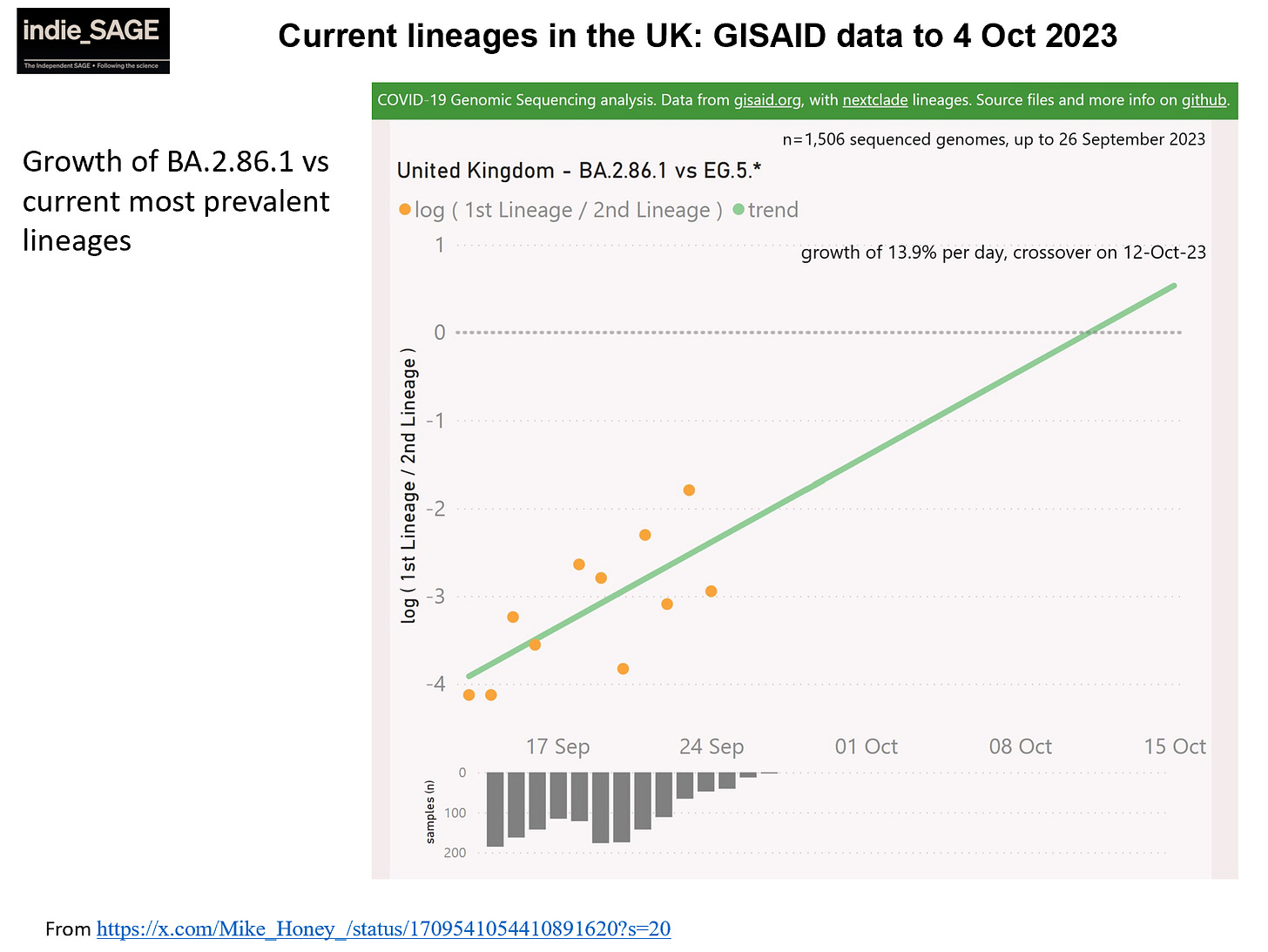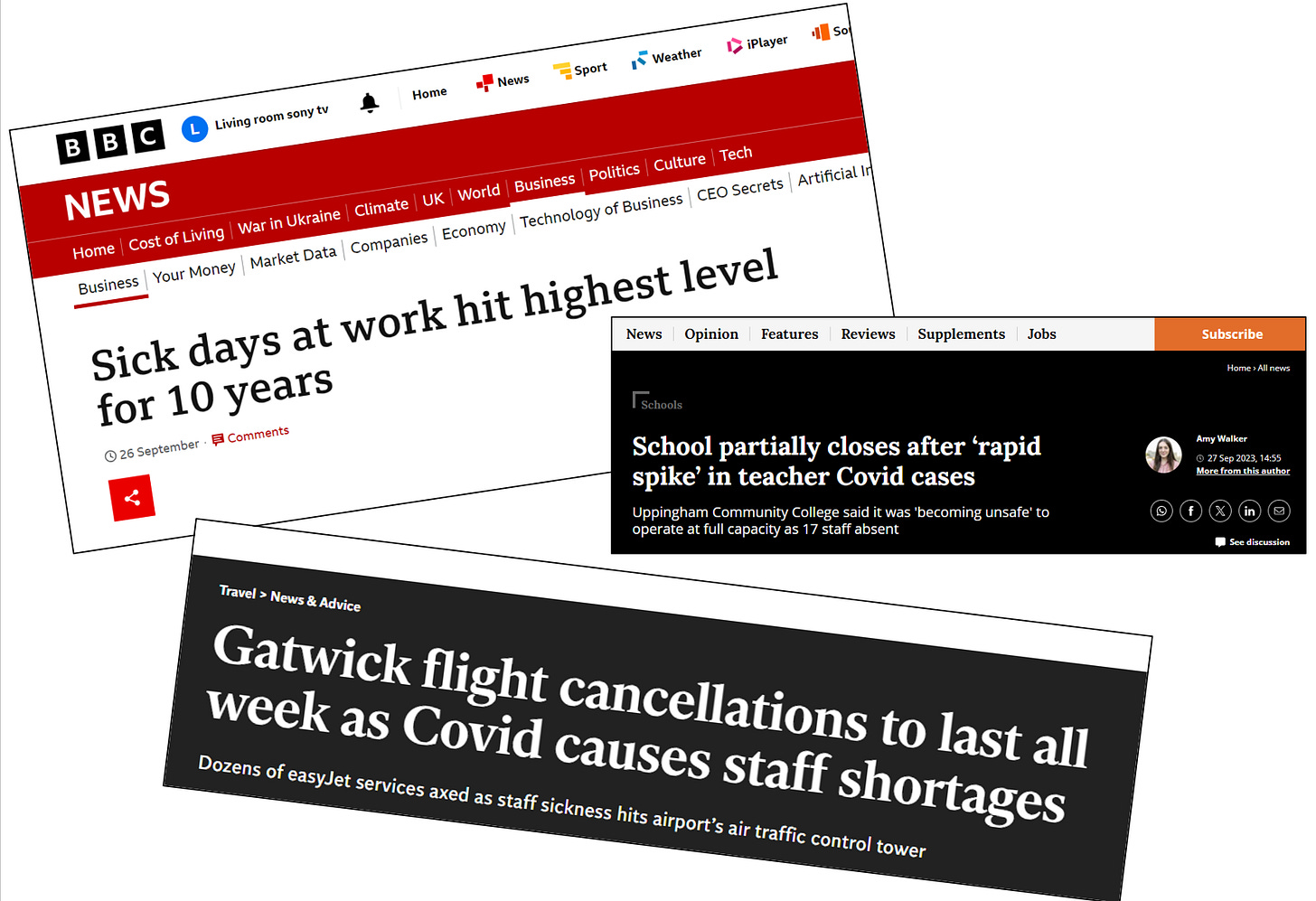Latest Covid situation in the UK: 6 Oct 2023
We're in a significant wave, unlikely to end just yet
In this substack, I’ll cover the latest on vaccination, cases, hospital admissions, deaths, variants and workforce disruption… so quite a bit to say this week!
Vaccines
The autumn 2023 campaign is underway - so far 3 million boosters given in England, with half of those in the most recent week to 1st Oct. NHS England estimated that about 21.5 million people are eligible for the autumn booster, which means we’re currently at about 14% uptake, so quite a long way to go.
Scotland and Wales have started their campaigns too, but only Wales has detailed uptake data so far (England publishes its coverage estimates next week).
Wales has done well in protecting the majority of care home residents, but still very early days for all the other eligible groups. Likely a similar picture in the other home nations. Please do get vaccinated if you are eligible - it will protect against both severe illness and Long Covid!
Unfortunately, a recent IPSOS poll showed that only a third of people are aware of who can get an autumn Covid booster - government and UKHSA need to do more to get the message out. As it stands too many people will miss out because they don’t know they are eligible and some will be disappointed by being refused.
Eligible groups are given below - note that if you have regular contact with a vulnerable person (e.g. elderly relatives), you might be eligible as a carer! Speak to a pharmacist or GP to check! Also note that if you are pregnant, you are eligible - a vaccine helps protect both you and your baby!
Infections
We know much less about how many people are infected than we used to, with the end of the ONS Infection Survey in March 2023, the end of English wastewater testing in March 2022 and the petering out of the Zoe Symptom Tracker App about a month ago. However, there are clues (other than hospitalisations), suggesting that there is a lot of Covid around right now - for instance google trends shows that searches for Covid Symptoms are at their highest in a year.
Symptoms don’t necessarily mean you have Covid, but UKHSA data shows that there is very little Flu or RSV (another respiratory virus) around at the moment. The data does show quite a bit of Covid and quite a bit of Rhinovirus (causes common cold). So - if you have cold/flu symptoms it’s likely either Covid or a Rhinovirus cold! Please do test for Covid! Recent evidence suggests people test positive a bit later than they used to, so please don’t assume you don’t have Covid after one negative test. Rest assured though that LFDs work just fine on the latest variants!
The good news is that the ONS Infection Survey is returning from November 2023 and running through to March 2024. This will provide really important information on levels of infection in the community. However, they are using Lateral Flow Tests only and no PCR tests - this means some infections will be missed and also that we won’t get any more data on variants other than existing hospital PCR tests.
Hospital admissions and deaths
Before showing hospital data, it’s important to point out that PCR tests in hospitals have reduced over the past year and a half.
This means that you can’t directly compare recorded hospital admissions with Covid now to recorded hospital admissions with Covid a year or more ago. I’ve highlighted the different testing regimes in colours in the plot of English admissions below. That said, we are certainly in a wave, with a significant increase in admissions over the past month. Admissions have gone up in all regions of England except London which has been flat for a few weeks.
The number of people in critical care with Covid should be less affected by changes in testing (because they should still all be tested). The data there shows a steady increases since July but numbers are still, thankfully, lower than they were last autumn. The number of people hospitals specifically report being treated directly for Covid has also increased.
Unsurprisingly, the increases in infections and hospitalisations is also reflected in increases in deaths from Covid. The plot below shows the weekly number of registered deaths in England and Wales with Covid on the death certificate (these are NOT ‘incidental Covid’ deaths). A similar increase is seen in N Ireland and Scotland too. Deaths still far lower than a year ago which is good news - and the autumn booster should help maintain that. Nonetheless, over 15,000 people have died from Covid so far this year in the UK - it’s still not “just a cold”.
Variant update
The most recent UKHSA variant report from 27 September shows a veritable soup of variants sloshing around - most of them are Omicron XBB subtypes. Leading the pack are EG.5* subvariants (“Eris”) and XBB.1.16 (“Arcturus”) at about 30% of sequenced cases each. However, new kid on the block BA.2.86 (“Pirola”) is there at about 2%.
To understand what will happen with Pirola, we need to assess how fast it’s growing compared to the top lineage Eris - Mike Honey has luckily done just that!
Even though Pirola growth looks slow, this is partly an artefact of exponential growth in its early stages. In fact, Pirola has about a 14% growth advantage over Eris, and is likely to become England’s most prevalent variant within a few weeks. This is partly why I think it’s unlikely the current wave is going to end soon.
Sickness
Although our main indicators of levels of infection have gone, we can still see the impact of infection in acute disruption. September saw various headlines highlighting high workforce absence and serious disruption to some flights and some schools from Covid outbreaks.
The latest ONS workforce data also shows record numbers of adults out of work because of long term sickness - 2.6m people! Certainly not all of that is Covid (long NHS waiting lists are also a factor) but Long Covid will be a signficant proportion.
Public still care about Covid
Finally, I just wanted to mention a recent IPSOS opinion poll, asking people about measures to avoid Covid infection over the next two weeks.
A significant minority are planning to work from home, reduce social contacts and wear a mask - and younger people more likely to take these measures than older adults! Most people also said they would still isolate as far as possible if they personally tested positive for Covid. To me this shows a few things. Firstly, real-time data on Covid remains important to enable individuals to decide on protective measures. Secondly, it shows that it’s not the case that everyone has moved on from Covid and we should just ignore it. And thirdly, it shows that if we could support safer indoor spaces (primarily through ventilation and air purification) we could not only reduce transmission but also support the economy by enabling more people to feel comfortable in restaurants, pubs, theatres etc. Clean air is a no-brainer intervention!
Conclusions
The autumn booster programme is underway - this is good news even though the UK is unusual in not offering it the population as a whole.
We are definitely experiencing a significant wave right now, and it seems likely to continue to grow over the coming weeks. Boosters will help blunt severe illness, but less so transmission because most under 65s not eligible. I think reintroducing masks in healthcare settings, as Canada has just done, to protect the most vulnerable makes a lot of sense.
We’ve seen signs of acute disruption in schools and workplaces and there will also be more people developing Long Covid. However, with no data now on Long Covid in the community, we have no way of tracking how many peple are affected or how badly.
The good news is that the ONS infection survey returns in November, albeit in reduced form.
PS thank you as ever to Bob Hawkins for helping with the slides!



















NB. I will be removing any blatant anti vax comments. Take anti vax views elsewhere.
Where is your evidence that the boosters are effective at all? It appears to me that Pfizer failed to do proper large scale testing. There are too many questions about safety for me to trust them ever again.